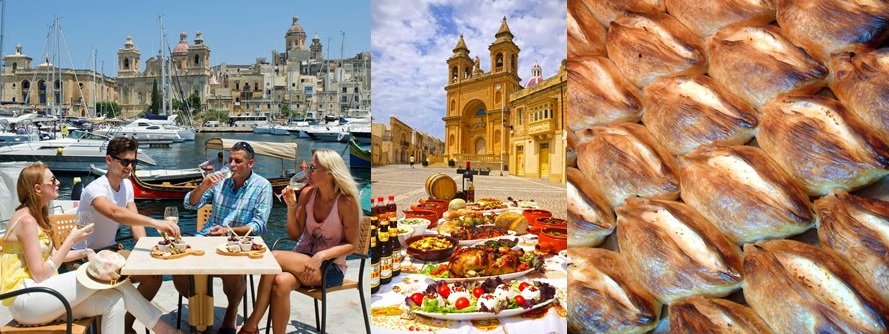Located in the heart of the Mediterranean, Malta is establishing itself as a gastronomic destination that serves up a wide range of dishes influenced by the many civilizations that made the Maltese archipelago their home. In a bid to embrace the long-standing and diverse culinary history of these Islands, the Malta Tourism Authority (MTA) has been championing local, sustainable gastronomy that tips its hat to traditional methods within the context of a modern and buzzing restaurant scene.
This year marked a new milestone for Malta with the announcement of the first Malta Michelin Guide, awarding the first Michelin stars on the Maltese islands. The new Michelin Guide highlights the outstanding restaurants, breadth of cuisine styles and culinary skills found in Malta, Gozo, and Comino. The winners of the first stars to be awarded in Malta are:
- De Mondion – Chef Kevin Bonello
- Noni – Chef Jonathan Brincat
- Under Grain – Chef Victor Borg
In addition to the Michelin starred restaurants, Malta of course also offers travelers a diverse culinary experience, from the traditional plate of eclectic Mediterranean food curated by a relationship between the Maltese and the countless civilizations that occupied the island, to the never-ending vineyards delivering the finest wine. The Maltese Islands rely on their abundance of assorted produce, from the mountains, the ocean, and the farms to bring the farm to table concept to life.
Traditional Maltese Cuisine is based around the seasons where eateries that offer the local fare, also serve their own unique versions of specialties. Maltese food is influenced by the islands’ close proximity to Sicily and North Africa but adds a Mediterranean flair of its own. Some popular local fare consists of Lampuki Pie (fish pie), Rabbit Stew, Bragoli, Kapunata, (Maltese version of ratatouille), and also Bigilla, a thick pate of broad beans with garlic served with Maltese bread and olive oil.
Traditional Maltese Cuisine is based around the seasons where eateries that offer the local fare, also serve their own unique versions of specialties. Maltese food is influenced by the islands’ close proximity to Sicily and North Africa but adds a Mediterranean flair of its own. Some popular local fare consists of Lampuki Pie (fish pie), Rabbit Stew, Bragoli, Kapunata, (Maltese version of ratatouille), and also Bigilla, a thick pate of broad beans with garlic served with Maltese bread and olive oil.
Marsaxlokk fish market is where locals go to get their catch of the day. Fresh fish from the Mediterranean Sea, plainly cooked is a consistent feature of Maltese cuisine. When fish is in abundance, Aljotta, a bowl of fish soup is a traditional dish. Depending on the season, spnotta, dott, cerna and trill are notable catches. Around early to late autumn, the famed lampuka, or dolphin fish will be in season. Other seafood including Octopus and squid are often used to make rich stews and pasta sauces.
Pastizzi – the Iconic Maltese Street Food
Not to be missed, eating Pastizzi fresh from the oven. One of Malta’s iconic street foods, Pastizzi is a flaky diamond-shaped pastry filled with ricotta and alternatively can be stuffed with mushy peas, spinach, tuna, or rabbit. Selling for less than €1, this delicacy can be found in every village across the island. A local bar, right outside of Mdina called Crystal Palace is said to be home to the best pastizzi Malta has to offer. They are baked on location guaranteed to always be fresh and hot.
Maltese Award-Winning Wine
There is nothing better to accompany local Maltese dishes than a wine produced on the Islands. Maltese vintages are more than holding their own at international competitions, winning several accolades in France, Italy and further afield. The climatic, geographical, and soil conditions on the island provide ideal conditions for the production of wines which have brilliant colors, clean aromas, and lively acidity. Meridiana’s Wine Cellars produces some of the finest Maltese wines using only Maltese grown grapes. Some of the most renowned wines include Cabernet Sauvignon, Merlot, Syrah, Sauvignon Blanc, Chardonnay, Vermentino, and Moscato. Many of the local wineries offer visitors wine tasting tours.
Maltese Annual Olive Picking Festival
Olive groves are an important aspect of Malta’s food scene. Malta celebrates the start of the olive picking season with a festival called Żejt iż-Żejtun in September. The festival is centered around the blessing of olives carted or carried by local farmers, followed by pressing and free tasting of Maltese ftajjar dressed in freshly pressed olive oil. Olive oil is vital in many traditional Maltese dishes.
About Malta
The sunny islands of Malta, in the middle of the Mediterranean Sea, are home to a most remarkable concentration of intact built heritage, including the highest density of UNESCO World Heritage Sites in any nation-state anywhere. Valletta built by the proud Knights of St. John is one of the UNESCO sights and the European Capital of Culture for 2018. Malta’s patrimony in stone ranges from the oldest free-standing stone architecture in the world, to one of the British Empire’s most formidable defensive systems, and includes a rich mix of domestic, religious and military architecture from the ancient, medieval and early modern periods. With superbly sunny weather, attractive beaches, a thriving nightlife, and 7,000 years of intriguing history, there is a great deal to see and do. For more information on Malta, visit www.visitmalta.com
GOT NEWS? click here
Google News, Bing News, Yahoo News, 200+ publications
#rebuildingtravel
MEDIA CONTACTS:
Malta Tourism Authority – North America
Michelle Buttigieg
P 212 213 0944
F 212 213 0938
E-mail: michelle-margaret.buttigieg@visitmalta.com
MTA US/Canada Editorial Contact:
The Bradford Group
Amanda Benedetto/ Gabriela Reyes
Tel: (212) 447-0027
Fax: (212) 725 8253
E-mail: info@bradfordglobalmarketing.com







